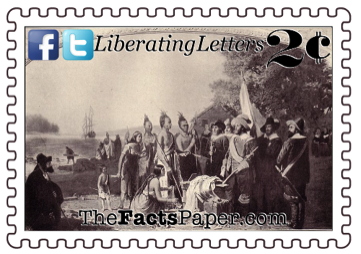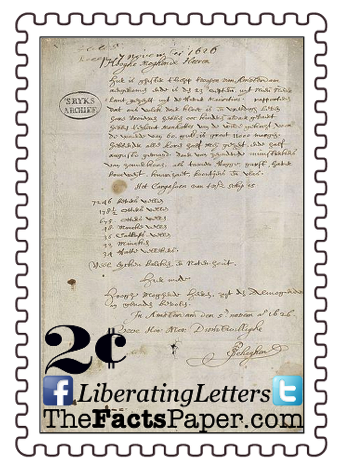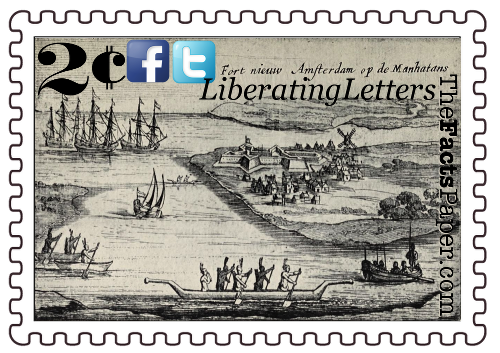Those who want to paint America's beginning as deceitful and cruel to the Native Americans use this deal as evidence of the supposed thievery. However, an honest review of the facts give a bit of a different story.
No other documentation, including a deed, no longer exists for this transaction. Even the actual date of the purchase is unknown, but history recognizes it as the day Minuit landed in New Amsterdam, May 4th. However, details can be derived from the 1630 purchase of Staten Island. The Dutch also acquired that island for 60 guilders in the form of "trinkets" and "beads", as noted by that deed. Many misinterpret these terms and believe the white man stole land from the natives with cheap, trivial items. Yet, this accepted viewpoint implies the Native Americans were too ignorant to understand the transaction taking place.
Many argue the supposed nonviolent, pacifist Indians really didn't comprehend they were selling the land as they did not believe land could be owned. However, this argument must willfully ignore the fact that tribes, long before the white man ever came to America, fought and killed other tribes because of land, hunting rights, mates, and sometimes simple hatred for the other tribe. They definitely had a concept of ownership, otherwise they would have peacefully shared territory or they would have willing given it up for the intruding tribe. That being said, there is a reasonable theory the Indians were just selling hunting rights or rights to use the land, maybe not necessarily full ownership.
In 1846, an historian arbitrarily equated 60 guilders as $24, concluding Minuit basically stole the valuable island from the Indians. Many agree. The problem with this argument is they are viewing 1626 Manhattan through 21st century eyes. If the Indians had built skyscrapers on the island, populated it with millions of dollars worth of businesses and housing, and made it the economic powerhouse it is today, then yes, it was a steal. However, 1626 Manhattan was just a well-located island with little settlement and used for hunting. It wasn't worthless to the Indians, yet it wasn't invaluable either.
Walt Disney did not buy up valuable swampland on which to build a multi-million dollar amusement park. He made cheap, worthless swamp land valuable BY building a multi-million dollar park on it. Likewise, Las Vegas was and still would be just empty desert if some mobsters had not decided to build the gambling capital of the world there. The worth of these regions comes from what people invested into them. Therefore, the original purchase price of Manhattan is irrelevant, except in analyzing how capitalism and entrepreneurship can add market value to certain land and surrounding areas. (see First Blood, Captain Molly, Famous Last Words, The Forgotten Holiday, and Never Forget)
Rcvd. 7 November 1626
High and Mighty Lords,
Yesterday the ship the Arms of Amsterdam arrived
here. It sailed from New Netherland out of the River
Mauritius on the 23d of September. They report that
our people are in good spirit and live in peace. The
women also have borne some children there. They
have purchased the Island Manhattes from the
Indians for the value of 60 guilders. It is 11,000
morgens in size [about 22,000 acres]. They had all
their grain sowed by the middle of May, and reaped
by the middle of August They sent samples of these
summer grains: wheat, rye, barley, oats, buckwheat,
canary seed, beans and flax. The cargo of the
aforesaid ship is:
7246 Beaver skins
178 1⁄2 Otter skins
675 Otter skins
48 Mink skins
36 Lynx skins
33 Minks
34 Muskrat skins
Many oak timbers and nut wood.
Herewith, High and Mighty Lords, be commended to the mercy of the Almighty,
In Amsterdam, the 5th of November anno 1626. Your High and Mightinesses’ obedient, P. Schaghen
May 4, 2017
Dear Liberty,
Peter Minuit left for New Netherlands in the New World, anxious to see how the colonists and the natives were getting along. He was not sure what to expect when the Dutch West Indies Company hired him to replace Willem Verhulst as director in New Amsterdam. However, he knew his goal was to secure land claims in the New World as well as strengthen trade with the Indians.
The Dutch wanted to expand their hold in the area Henry Hudson recently explored for the Dutch West Indies Company. Minuit first planned to visit the fort at New Amsterdam, established the previous year, on the southern part of an island located at the mouth of the river Hudson surveyed. The Dutch quickly learned local natives regarded trade and gift giving as alliance-building practices. In addition, they used special beads, which they called wampum, as currency.
Arriving on May 4, 1626, Minuit set foot on land, ready to get to work. He quickly began negotiations with the local Lenape Indians and acquired the Island of Manna-Hattin for 60 guilders in the form of trinkets and tools. Now known as New York City’s Manhattan, many contend it was obtained for pennies on the dollar and often described as one of the most shrewd deals ever made. But is it?
Details about the transaction are obtained from the Dutch government liaison to the Dutch West Indies Company, Peter Schaghen. He garnered information in November 1626 from those returning from the New World and penned the following letter to the government leaders regarding Minuit's purchase.
It is widely known the Indians used wampum as legal tender. The beads had real value to them and highly acceptable for trade. The Indians were not naively accepting little flashy, worthless baubles, but rather knowingly accepting relevant, common, and proper payment.
Likewise, the "trinkets" traded included advanced English items such as axes, hoes, kettles, musical instruments (Jew's harps), but most importantly, drilling awls. The Indians desired the awls as they increased wampum making abilities. The axes and hoes increased their farming production, while the kettles improved cooking. While these items may have been inexpensive "luxuries" to the Dutch, they were innovative improvements for the Indians, which in and of itself increased their value to the Indians.
Unfortunately, over time, many have rewritten history for their own purposes, or out of their own ignorance, to characterize the Dutch as thieves instead of explores, opportunists and entrepreneurs. However, Liberty, the Manhattan Island purchase is a perfect example of capitalism and free enterprise. The Dutch saw value where the Native Americans did not. There is nothing wrong with that. Xerox first invented the mouse, but could not find a purpose for it. It wasn't until Steve Jobs of Apple, Inc. was shown the technology and created a use for it did it then become valuable. On the other hand, some narratives claim the particular tribe Minuit bartered with for the land eagerly did so because it was another tribe that laid claim to it. So, it is possible it was the Indians that snookered Minuit and not the other way around as the Dutch had to purchase the land again later from the real owners.
This letter demonstrates and corrects many misconceptions now taught in schools. The Europeans did not steal land, they purchased it. The white man did not come to America with the intent of irradiating the natives, though blood was shed from aggressiveness displayed on both sides, but to live beside (see The Unbroken Treaty) and trade with them (see Join, Or Die, Bulletproof, and Where The River Flows). The Indians were not helpless, naive, or duped by shiny beads. Instead, they were shrewd businessmen understanding the value in the “trinkets” offered them.
Liberty, until we honestly learn and truly understand our past, can we successfully move towards our future, liberating the generations to follow. The most important way to do that is to share the Gospel. As sinful human beings, there is nothing we can do to earn worth. God did it all by sending His only son, Jesus Christ, to pay for our sins. Christ purchased us with His own blood, cleansing us of our sins, and turning us into God's precious, priceless children. That is the most liberating news of all!
That’s my 2 cents.
Love,
Mom
WAMPUM ON
THE DOLLAR





